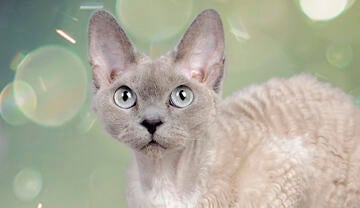Non esistono gatti privi di allergeni o "ipoallergenici"


Una credenza diffusa è che alcune razze di gatti, specialmente quelle senza pelo, siano "ipoallergenici".
Sebbene "ipoallergenico" tecnicamente significhi "meno allergenico", molte persone usano questo termine nel significato di "privo di allergeni".
Numerose fonti, tra cui i siti Web dedicati alle diverse razze, suggeriscono che questi gatti "ipoallergenici" eliminano le reazioni allergiche negli individui sensibili. Tuttavia, non esistono gatti realmente privi di allergeni.1-4 Sebbene alcuni gatti possano perdere meno peli, in realtà non sono i peli a causare una reazione allergica. Le persone allergiche ai gatti rispondono infatti agli allergeni prodotti principalmente dalle ghiandole salivari e sebacee (cutanee).1,2
Dati oggettivi
Non esistono gatti realmente "ipoallergenici" o privi di allergeni.
- Anche se la produzione di allergeni varia ampiamente tra i singoli gatti, e può variare nel corso dell'anno in un stesso esemplare, tutti i gatti producono Fel d 1 (il principale allergene dei gatti), indipendentemente dalla razza.1-7
- Poiché Fel d 1 viene prodotto nelle ghiandole salivari e sebacee (cutanee) del gatto, anche i gatti senza peli, come Cornish Rex e Sfinx, producono comunque allergeni.1-7
- Tutti i gatti si puliscono il mantello e producono forfora, che si disperdono poi (insieme agli allergeni) nell'ambiente.1-8
Ulteriori informazioni
- Bastien, B., Gardner, C. & Satyaraj, E. (2019). Influence of phenotype on salivary Fel d 1 in domestic shorthair cats. Accepted, Journal of Feline Medicine and Surgery.
- Bonnet, B., Messaoudi, K., Jacomet, F., Michaud, E. Fauquert, J. L., Caillaud, D., & Evrard, B. (2018). An update on molecular cat allergens: Fel d 1 and what else? Chapter 1: Fel d 1, the major cat allergen. Allergy, Asthma and Clinical Immunology, 14, 14. doi: 10.1186/s13223-018-0239-8
- Kelly, S.M., Karsh, J., Marcelo, J., Boeckh, D., Stepner, N., Litt, D.,...Yang, W.H. (2018). Fel d 1 and Fel d4 levels in cat fur, saliva and urine. Journal of Allergy and Clinical Immunology. doi: 10.1016/j.jaci.2018.07.033
- Dávila, I., Dominguez-Ortega, J., Navarro-Pulido, A., Alonso, A., Antolin-Amerigo, D., Gonzalez-Mancebo, E., Martin-Garcia, C., Nunez-Acevedo, B., Prior, N.,…Torrecillas, M. (2018). Consensus document on dog and cat allergy. Allergy, 73, 1206-1222. doi: 10.1111/all.13391
- Salo, P.M., Cohn, R.D., & Zeldin, D.C. (2018). Bedroom allergen exposure beyond house dust mites. Current Allergy and Asthma Reports, 18, 52. doi: 10.1007/s11882-018-0805-7
- Butt, A., Rashid, D., & Lockey, R. (2012). Do hypoallergenic cats and dogs exist? Annals of Allergy Asthma and Immunology, 108, 74-76.
- Nicholas, C., Wegienka, G., & Havstad, S. (2008). Influence of cat characteristics on Fel d 1 levels in homes. Annals of Allergy Asthma and Immunology 101, 47-50.
- Luczynska, C., Li, Y., Chapman, M., & Platts-Mills, T. (1990). Airborne concentrations and particle size distribution of allergen derived from domestic cats (Felis domesticus). Measurements using cascade impactor, liquid impinger, and a two-site monoclonal antibody assay for Fel d 1. American Review Respiratory Diseases, 141, 361-367.
